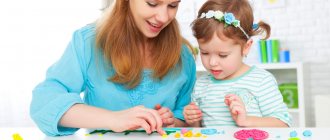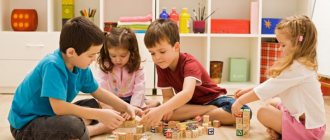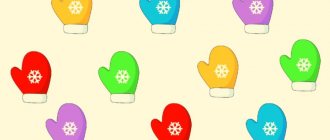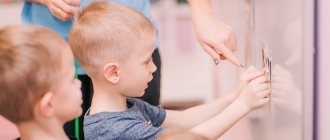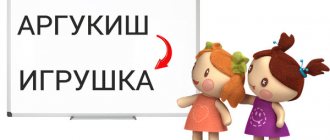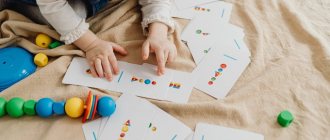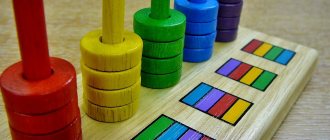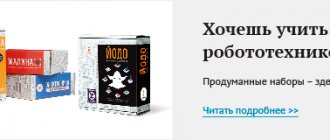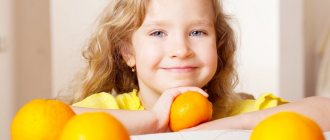Didactic games for the development of thinking
Thinking is one of the highest forms of human activity, and is also a socially determined, mental process inextricably linked with speech.
In the process of mental activity of each person, certain techniques or operations are developed: analysis, synthesis, comparison, generalization, specification. There are three types of thinking:
1) visual and effective (children learn about the world by manipulating objects);
2) visual-figurative (children can already imagine objects or phenomena in the environment);
3) verbal-logical (children use concepts and know how to reason).
Visual and effective thinking develops with particular intensity in a child from 3 to 4 years old. Children become familiar with the properties of objects, learn to operate objects, establish relationships between them, and also solve a variety of practical problems.
Based on visual-effective thinking, a more complex form of thinking is formed - visual-figurative. This is thinking in images, ideas, transforming a situation into a figurative form. It arises when the child has sufficient experience of practical actions and, instead of realities, he resorts to mental attempts to change the situation, imagining the necessary actions and the results obtained. Also, visual-figurative thinking allows the child, for example, to use schematic images or count in his head.
By the age of six to seven years, verbal-logical thinking, which is associated with the use and transformation of concepts, begins to develop more intensively in preschoolers. Thinking now appears not only in the form of practical actions, and also not only in the form of visual images, but, above all, in the form of abstract concepts and reasoning. However, verbal-logical thinking is not the leading one in preschoolers.
All types of thinking are closely related to each other. When solving problems, verbal reasoning is based on vivid images, and at the same time, solving even the simplest, most specific problem requires verbal generalizations from the child.
Reading fiction, designing, various games, modeling, drawing, etc., that is, everything that a child does before school, develops such mental operations as generalization, comparison, abstraction, classification, establishing cause-and-effect relationships. , understanding of interdependencies, ability to reason.
In the development of thinking and other mental processes of preschoolers, play is of great importance, the process of which is associated with the properties of objects (their shape, weight, size, color, features), and the performance of various actions with them. This promotes a comprehensive study of these subjects and creates conditions for the simultaneous interaction of various senses.
Examples of games for developing the thinking of preschoolers.
1) “Gather a big family”
Pictures depicting animals, vegetables, fruits, transport, etc. are selected. These pictures are laid out in front of the children and the task is given to gather large families.”
2) “Favorite food”
Pictures depicting animals and food for these animals are selected. Pictures of animals and separate pictures of food are laid out in front of preschoolers; each animal is invited to lay out its favorite food.
3) “Find the baby’s mother”
Pictures of domestic animals are laid out in front of the children: dog, cat, pig, cow, etc. and separate pictures: kitten, puppy, piglet, calf, etc., it is suggested to find the baby’s mother.
4) “Call it in one word”
Pictures are laid out in front of preschoolers, and an adult asks them to look at them and name them in one word. For example: train, plane, car - transport; fox, hare, bear - wild animals; apple, pear, plum - fruits, etc.
5) “Magic bag”
Toys are selected in the bag: red, blue, green, yellow. Pictures depicting: a red apple, a blue cloud, a green grasshopper, a yellow chicken are laid out on the table; preschoolers are invited to choose friends for them by color by taking out the corresponding toys from the bag.
6) “Gather friends”
Children are given a set of pictures depicting various objects. The adult asks to consider them and put them into groups, i.e. suitable with suitable.
7) “Lay out the pictures”
Ready-made series of plot-based sequential pictures are used. Preschoolers are given pictures and asked to look at them. They explain that the pictures should be arranged in the order in which events unfold. In conclusion, the children make up a story based on the pictures.
8) “What’s extra?”
Select a series of pictures, among which three pictures can be combined into a group according to some common characteristic (animals, transport, flies, jumps, soft, cold, etc.), and the fourth picture is extra. Invite the children to find the extra picture. Ask why they think this way and how the pictures they left are similar.
9) "Alternation"
Invite preschoolers to draw, color, or string beads. Please note that the beads must alternate in a certain sequence, for example, by color: red, blue, yellow, green, etc. In the same way, you can suggest drawing a multi-colored fence, or laying it out on the table from multi-colored sticks, etc.
10) “Find the extra word”
An adult reads a series of words, for example: animals, vegetables, fruits, etc. and invites preschoolers to clap their hands when they hear an extra word; you can also choose a child who will explain why the word is extra, to which group he would associate it.
11) “Who is faster”
An adult, throwing a ball to a child, names a color, and the child, returning the ball, must quickly name an object of this color. You can also name not only the color, but also the quality (for example: taste, shape) of an object.
12) "Professions"
An adult shows children pictures of people’s professions and asks them to name what people in a certain profession do. For example, a doctor treats people, a builder builds houses, a teacher teaches something to children at school, etc. Showing can be replaced with facial expressions and pantomime.
13) “Tell me the other way around”
Offer your preschoolers the game “I will say a word, and you will also say it to me, only in reverse, for example, big - small.” You can use the following pairs of words: cheerful - sad, fast - slow, empty - full, smart - stupid, hardworking - lazy, strong - weak, heavy - light, cowardly - brave, white - black, hard - soft, rough - smooth and etc.
14) "Guess"
An adult asks you to guess which animal, vegetable, fruit, vehicle, etc. He says. It is imperative to give children a specific, clear description of each item. For example: This is a fruit. It is red, round, juicy (Apple).
15) “Guessing riddles”
Invite children to guess descriptive riddles on various topics (flora and fauna, natural phenomena, vegetables/fruits, objects, etc.) For example: Long-eared, shy, loves to eat carrots and cabbage (Hare); Red-haired, she has a fluffy tail, deftly jumps through the trees (Squirrel), etc.
16) “Migratory and wintering birds”
Preschoolers are presented with pictures depicting migratory and wintering birds, as well as two identical pictures depicting a tree. They need to put all the migratory birds on one tree, for example: swallow, starling, rook, cuckoo, lark, etc., and on another - wintering birds, for example: tit, sparrow, crow, bullfinch, etc.
17) “Flies, swims, crawls”
An adult gives children pictures depicting those who can fly, swim, crawl. Then he lays out pictures on the table depicting the sky, sea, grass and asks to match the animal, bird, insect, fish, etc. with the corresponding picture, asking the question: “What can he do...” (Bird, beetle... - fly; hare, grasshopper - jump...; snake, snail - crawl...)
18) “Find something similar”
Preschoolers are offered geometric shapes and various objects. The task is to form groups of objects based on their similarity to a certain geometric figure. For example, a circle is a ring, a lid..., a square is a box, a cube... etc.
19) "Domestic and wild animals"
Pictures depicting domestic and wild animals, as well as two pictures are laid out in front of the children: the first one shows a house, the second one shows a forest. They need to place domestic animals around the house and wild animals around the forest.
20) “Our favorite winter and favorite summer”
An adult lays out two pictures “Winter” and “Summer” on the table in front of the preschoolers, as well as pictures depicting various winter and summer clothes and accessories. Children need to relate to the season what people usually wear when it comes. (For example, “Winter” - fur coat, scarf, mittens..., “Summer” - shorts, T-shirt, hat...)
Author: Irina Bagmenko, Master of Preschool Education, Lugansk, Ukraine.
Development of logical thinking
Children already in early preschool age are faced with a variety of sizes, shapes, and colors of objects around them. The perception of the surrounding world occurs without special preparation. However, if assimilation occurs intuitively, it is most often incomplete and superficial.
The development of logic and thinking is an integral part of a child’s successful preparation for school and his harmonious development.
Senior preschool age is marked by the beginning of the emergence of the sign-symbolic function of consciousness. This period becomes important in general for mental development, for the formation of readiness for schooling.
It is customary to use symbolic symbols to designate objects, sequences, and sets, which is what children are introduced to in preparation for school. The kids actively accept it.
Especially if such models are invented together, focusing on the use of notation not only in words, but also graphically (for example, not only rectangles, but also other figures that have 4 corners fall into one group of objects, emphasis is placed on the number “4”) .
Game "Choose an item"
Various objects are laid out in front of the student to choose from: an apple, a ball, a button, a chess piece for children, a book, etc. The older the children, the more objects there are and the more similar they are to each other. Next, the baby is given instructions. For example, “This object is round. It is medium in size. It’s not red, etc.” or “It's blue, but it's not round.” The task is to find this item. This game is often found in centers preparing children for school, since a first-grader must be able to see logical relationships and easily find them.
For parents to develop their child’s logical thinking
A preschooler who knows how to use logical operations is doomed to successful learning and no problems in the cognitive sphere, since his intellectual level will help him cope with difficulties.
If you want to help your child be successful, we recommend using the following developmental tasks. They will turn your communication into a fun and useful game.
To start classes with a child, it is not necessary to have a pedagogical education.
We recommend alternating types of games to develop different types of thinking.
Oral games
Word games are simple, accessible, do not require special preparation, and can be played in any convenient place. Such tasks develop horizons, clarify, and enrich vocabulary. Choose those that teach you to find analogies, generalize, classify objects and phenomena into groups, and make logical connections.
- Come up with a new ending for a famous fairy tale;
- Compose a story, poems together, that is, one begins, the other continues in meaning;
- Play “riddles”: the parent riddles an object, object or phenomenon and invites the child to guess it using questions that can only be answered “yes” or “no”;
- Play “I believe it or not.” You say a statement, for example, “All dogs are purebred” or “A pear is a tree.” The child answers whether the given sentence is correct. If the answers and decisions are controversial, so much the better; there is an opportunity to reflect and come to an answer using logical reasoning.
Game “Associations” (we develop verbal and logical thinking)
Assignment: choose the appropriate word for the one indicated according to a certain attribute corresponding to the one present in the previous pair, explain your choice.
Art lesson on the topic “Border guard with a dog” in senior groups of preschool educational institutions
For example, a bird is a nest, a person is ?. The bird lives in a nest, which means that for the word “person” we will select a word denoting housing - “house”.
- Deaf - song, blind - ... (picture);
- Airplane - pilot, bus - ... (driver);
- Summer - cap, winter - ... (hat);
- Ladle - pan, spoon - ... (glass, glass);
- Spoon - soup, fork - ... (salad, potatoes, meat, noodles), etc.
Game “Say it in one word” (we develop logical operations of classification, generalization)
Assignment: you must name the presented group of words with one generalizing word and explain your decision.
- Kissel, compote, tea, fruit drink (drinks);
- Microwave oven, vacuum cleaner, hair dryer, bread maker;
- Nest, hollow, hole, anthill;
- Bicycle, scooter, airplane, motorcycle;
- Baker, tour guide, seamstress, salesman, etc.
Games using cards, paper, pen
Preschoolers enjoy games that use bright pictures. You need to take advantage of this by using not only cards, but also a pen and paper. The proposed ideas can be supplemented with your own, complicating or simplifying at your discretion.
- Use games to compare and group objects;
- Use ready-made puzzles with matches;
- Compose coherent stories based on the plot pictures. It will be useful to offer them to the child in the wrong order at the beginning;
- Go through labyrinths, rescuing heroes, solve riddles and puzzles on paper.
Board games
Colorful boxes with sets of drawings, rules, and figures attract not only preschoolers, but also their parents. An evening spent in a close family circle is useful both for communication with family and for the development of a little fidget. Lotto, sea battle, chess are classic games that have stood the test of time.
These are activities that will always be relevant and suitable for family holidays. They teach you to win gracefully and accept defeats, to enjoy communication and the process of the game.
In addition, tiles and pictures from board games can be used for teaching. Let's consider several ways.
- Invite your preschooler to recognize objects with his eyes closed, by touch;
- Arrange objects according to a certain algorithm. For example, make sequences of them: increasing, decreasing, by color, size, shape;
- Use dominoes and triminoes to learn counting, addition and subtraction.
alt: Rules of the game “Trimino”
Logic chains
Finding patterns and common properties between two objects is incredibly interesting! Children in early development centers love to do this. Offer your baby two words, for example, “flower” and “butterfly.” He needs to find as many connections between these words as possible.
At the “Names Production” Center for the Development of Successful Children, we use an integrated approach to the development of a child’s personality. Along with creative activities (children's vocals, children's drawing lessons, acting), your child will develop flexible thinking, logic, the ability to analyze and draw conclusions, and communicate successfully. Take the first step to success with Names Production!
Diagnostics of logical thinking
Logical thinking is one of the main indicators of the quality of a person’s thinking. The ability of a preschooler to independently think logically, identify essential features of objects, actions and phenomena, systematize, generalize, classify, draw inferences and conclusions, substantiate his judgments, prove their truth arises and is formed in the course of his intellectual development.
We wrote in more detail about diagnosing the thinking of preschoolers earlier.
As you develop your child, pay attention to his ability to think logically. How favorably he will stand out among his peers depends on this important indicator.
Exercises for diagnostics
alt: Diagnostics of the thinking of preschoolers
Logical operations
The structure of thinking includes operations, the presence of which in a preschool child implies full mental development. Operations are:
- Comparison is an operation associated with the establishment of similar and distinctive features of any objects. As a result of a logical operation, a classification may appear;
- Analysis is a mental process associated with the division of a complex object into its individual characteristics or parts. The next stage of analysis is comparison;
- Synthesis is a logical operation that combines disparate parts into one whole concept, object;
In psychology, analysis and synthesis are usually viewed as interchangeable operations.
- Abstraction is the mental separation of essential properties, connections, characteristics of an object from non-essential ones. The presence of the ability to perform such an operation indicates the appearance of abstract logical thinking in the baby;
- Generalization - the operation appears as the child’s vocabulary accumulates, and is associated with the imaginary association of phenomena, objects, actions according to significant characteristics;
- Classification is a thinking operation in which the order of things and phenomena is comprehended and divided according to some criterion;
- Concretization is a logical operation by which a preschooler uses the replacement of a word with a concept with a more specific meaning.
Legal education of preschool children in kindergarten

